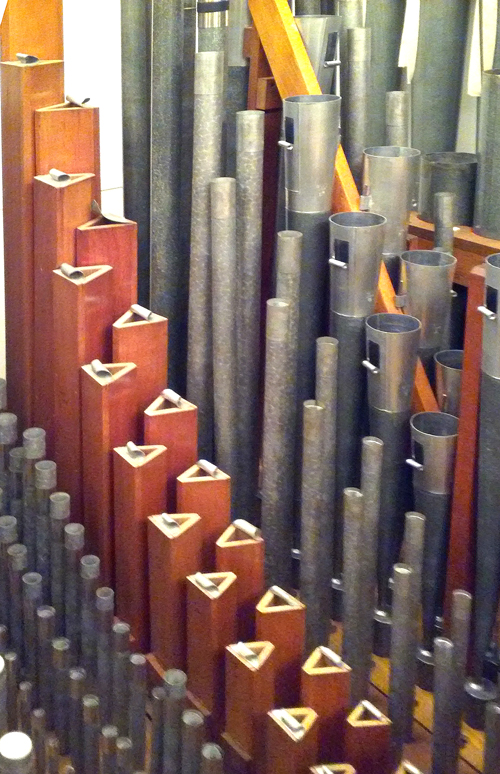The PIPE ORGAN
North Suburban HAMMOND ORGAN Service
Elementary Pipe Organ Terms
Before we go any further, it is probably important to define some basic terms and design concepts associated with pipe organs. Like any specialized field, there are many specific terms that relate to the pipe organ, as well as some specific jargon. Giving you, the reader this information now makes my subsequent writing work a lot easier, because then I may use the terms in this article, confident that you will understand what they mean.
Like our familiar electronic instruments, pipe organs are capable of a wide variety of different tonal effects and sounds. Some of these are specific to the pipe organ, whereas others are imitative of other instruments. In certain cases, the imitations provided by pipe organs are more accurate than those provided by many analog electronic organs. Some pipe organs also contain other actual instruments which are played electrically from the pipe organ's keys and pedals. In this instance, the imitations are no longer imitations, but the real thing. This is particularly true of the theater pipe organ, but it also applies to many concert instruments as well.
We can broadly classify pipe organs into three occasionally somewhat overlapping groups which are;
Classical instruments (usually found in churches)
Concert organs (used in large public buildings, music halls and some larger churches, and
Theater organs, designed specifically for the accompaniment of early silent movies and designed to allow one musician to replace an entire theater or stage orchestra.
In all but the very smallest instruments, there will usually be at least two keyboards, called manuals, and also a floor-level pedal keyboard, usually referred to as a pedalboard. For reasons which we'll look at later, organ keyboards are similar to piano keyboards but typically have only 5 octaves, or 61 keys instead of the piano's 88 keys or roughly 7.5 octaves. However, the actual pitch range of the pipe organ is frequently greater than that of the piano, exceeding it at both ends of the pitch range.
Figure 1. Interior of a large pipe organ, picture shows several different rows or ranks of pipes. Notice the unusual triangular wood pipes in the center.

Pipe organs consist of multiple ranks or sets of organ pipes; each rank (played from a keyboard) will have 61 pipes, all designed to produce the same tonality. Different tonal effects are the result of multiple ranks of pipes, but each 61 note rank has a specific tonality. For example, if one of the tonalities available on a certain pipe organ is called Concert Flute, then there will be a rank of 61 organ pipes that are designed to sound like a typical orchestral flute. Similarly if there is another tonality called Trumpet, there will be 61 more pipes in a second rank of pipes which will be designed to sound like a trumpet. Likewise, if another stop is called Clarinet, then there will be an additional set of 61 pipes that will sound like a real clarinet.
As a pipe organ builder adds more tonalities to an instrument, there will be an additional rank of 61 pipes for each possible tonality, so that in an instrument with perhaps fifty different tonalities, there will (in the standard or straight design) be fifty different sets or ranks of 61 pipes each. As you may infer, such an instrument will contain a total of at least 3050 organ pipes.
In a standard or straight instrument, there will also be some additonal ranks of 32 pipes each that will play from the instrument's pedalboard. The typical organ pedalboard has 32 keys, or two and one half octaves. We should note here that most electronic organs designed for pops music have an abbreviated pedalboard of two octaves plus top C or 25 pedals instead of 32. Also, many electronic instruments are spinets, designed for amateur or home usage and have only a one octave plus top C pedalboard of 13 pedals. Likewise, the spinets usually only have 44 keys on each of two manuals. With extremely few exceptions, however, all pipe organs have a minimum of two 61 note manuals and a full size 32 note pedalboard.
It's also interesting to note that the typical pipe organ pedalboard is arranged so that pedals are not parallel to each other but radiate or fan out so that the heel ends of the pedals are closer together. The pedalboard is also concave, in that pedals at each end are higher above the floor than those in the center. This follows the natural swing of a person's legs and the positions that our feet assume when over different parts of the pedalboard, and although it does not look that way at first, it is actually significantly physically easier to play such a pedalboard than the flat 25 note pedalboards of most electronic consoles, or especially the abbreviated flat and parallel pedals of spinets. But as far as technique goes, moving up from a spinet to a 32 note pedalboard and two-feet pedalling will take a significant bit of serious practicing. However, a flat, straight 13 note set of pedals on a spinet electronic is a lot cheaper to make, and the thought is that most amateur or home players who purchase such an instrument will only use their left feet on such a pedalboard and that there is no need to go any further. However, more serious musicians and indeed most literature for the organ require at the least a 25 note pedalboard, and generally the 32 note version. I am not aware of any pipe organ of recent construction that has anything less than a standard 32 note radiating and concave pedalboard unless it is a historical reproduction of an instrument from an earlier time period in which case it might have a non-standard pedalboard of fewer than 32 notes.
Previous Page Page3.
Next page